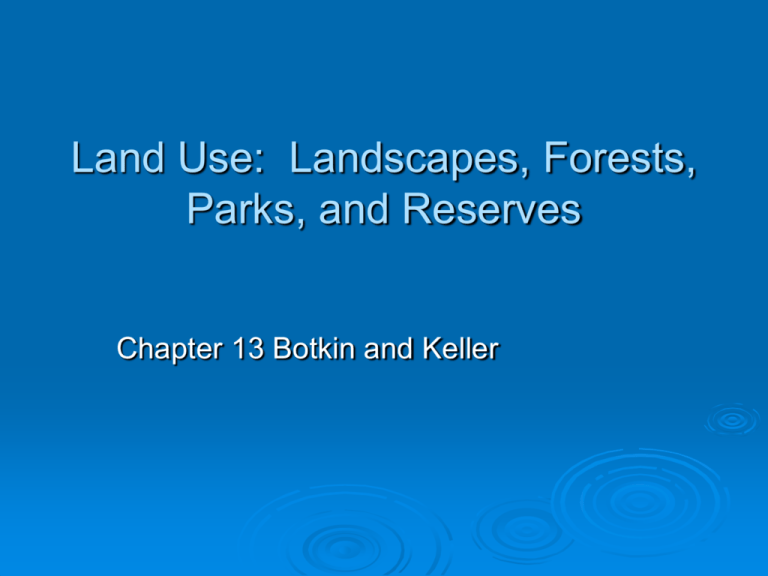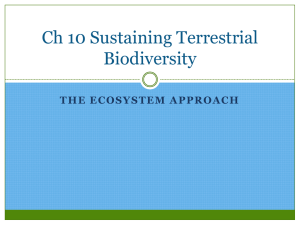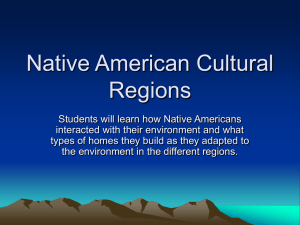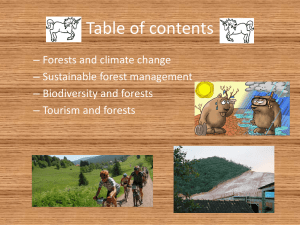Chapter 10
advertisement

Land Use: Landscapes, Forests, Parks, and Reserves Chapter 13 Botkin and Keller Core Case Study: Reintroducing Wolves to Yellowstone Endangered 1850-1900 two million wolves were destroyed. Keystone Species Species Keeps prey away from open areas near stream banks. Vegetation reestablishes. Species diversity expands. Figure 10-1 HUMAN IMPACTS ON TERRESTRIAL BIODIVERSITY We have depleted and degraded some of the earth’s biodiversity and these threats are expected to increase. Figure 10-2 Why Should We Care About Biodiversity? Use Value: For the usefulness in terms of economic and ecological services. Nonuse Value: existence, aesthetics, bequest for future generations. Figure 10-3 Natural Capital Forests Ecological Services Support energy flow and chemical cycling Reduce soil erosion Absorb and release water Economic Services Fuelwood Lumber Pulp to make paper Mining Purify water and air Livestock grazing Influence local and regional climate Recreation Store atmospheric carbon Jobs Provide numerous wildlife habitats Fig. 10-4, p. 193 Types of Forests Old-growth forest: uncut or regenerated forest that has not been seriously disturbed for several hundred years. 22% of world’s forest. Hosts many species with specialized niches. Mostly found in Russia, Canada, Brazil, Indonesia, Papua, New Guinea. Figure 10-5 Types of Forests Second-growth forest: a stand of trees resulting from natural secondary succession. Tree plantation: planted stands of a particular tree species; highly managed tree are uniform is size Figure 10-6 Weak trees removed Clear cut 25 30 Seedlings planted 15 Years of growth 10 5 Fig. 10-6, p. 195 Harmful Environmental Effects Of Deforestation • Decreased soil fertility from erosion • Runoff of eroded soil into aquatic systems • Premature extinction of species with specialized niches • Loss of habitat for native species and migratory species such as birds and butterflies • Regional climate change from extensive clearing • Release of CO2 into atmosphere • Acceleration of flooding Fig. 10-7, p. 196 Deforestation and the Fuelwood Crisis Almost half the people in the developing world face a shortage of fuelwood and charcoal. In Haiti, 98% of country is deforested. Solutions to deforestation problem 1. 2. 3. 4. Plant small tree plantations of fast growing trees for fuel. Also tree nuts can be used as protein source. Provide cheap, efficient method for cooking such as solar ovens or wind generated electricity. Burn dried roots of gourds. MIT scientist has found a way to make charcoal from spent sugarcane. Harvesting Trees Building roads into previously inaccessible forests paves the way for fragmentation, destruction, and degradation. Figure 10-8 Harvesting Trees Trees can be harvested individually from diverse forests (selective cutting), an entire forest can be cut down (clear cutting), or portions of the forest is harvested (e.g. strip cutting). Figure 10-9 (a) Selective cutting 1. Selective cutting: mark & cut individual trees; usually smaller, poorly formed trees. Sometimes trees of specific species are removed like mahogany. 2. Shelterwood cutting: cut dead & less desirable trees; leave others to mature later. 3. Seed- tree cutting: removes all but a few seed trees (mature trees w/ good genetics) to regenerate forest. Fig. 10-9a, p. 198 Benefits of selective cutting methods 1. 2. 3. 4. 5. Reduces crowding Removes diseased trees Encourages growth of young trees Maintains stand of trees of diff. species Allows forest to be used in multiple ways (b) Clear-cutting Disadvantages of clear cutting 1. Changes chemical cycling like N2 2. Run off high 3. EROSION!! 4. Open to sunlight & rain ground temp. increases 5. Exposed soil decays rapidly ** Not always bad evaluate on case by case basis. Fig. 10-9b, p. 198 (c) Strip cutting Uncut Cut 1 year ago Dirt road Cut 3–10 years ago Uncut Stream Fig. 10-9c, p. 198 Strip Cutting advantages 1. Uncut strips protect trees from wind and direct sunlight 2. Trees provide seeds 3. Minimizes negative aesthetic effects of logging; leaves corridor for wildlife 4. More sustainable yield w/out widespread destruction Harvesting Trees Effects of clear-cutting in the state of Washington, U.S. Figures 10-10 and 10-11 Trade-Offs Clear-Cutting Forests Advantages Disadvantages Higher timber yields Reduces biodiversity Maximum profits in shortest time Disrupts ecosystem processes Can reforest with fastgrowing trees Destroys and fragments wildlife habitats Short time to establish new stand of trees Leaves large openings Needs less skill and planning Good for tree species needing full or moderate sunlight Increases water pollution, flooding, and erosion on steep slopes Eliminates most recreational value Fig. 10-11, p. 198 Solutions We can use forests more sustainably by emphasizing: Economic value of ecological services. Harvesting trees no faster than they are replenished. Protecting old-growth and vulnerable areas. Figure 10-12 Solutions Sustainable Forestry • Identify and protect forest areas high in biodiversity • Grow more timber on long rotations • Rely more on selective cutting and strip cutting • Stop clear-cutting on steep slopes • Cease logging of old-growth forests • Prohibit fragmentation of remaining large blocks of forest • Sharply reduce road building into uncut forest areas • Leave most standing dead trees and fallen timber for wildlife habitat and nutrient recycling • Certify timber grown by sustainable methods • Include ecological services of forests in estimating their economic value • Plant tree plantations on deforested and degraded land • Shift government subsidies from harvesting trees to planting trees Fig. 10-12, p. 199 FOREST RESOURCES AND MANAGEMENT IN THE U.S. U.S. forests cover more area than in 1920. Since the 1960’s, an increasing area of old growth and diverse second-growth forests have been clear-cut. Often replace with tree farms. Decreases biodiversity. Disrupts ecosystem processes. Types and Effects of Forest Fires Depending on their intensity, fires can benefit or harm forests. Burn away flammable ground material; maintains habitat for small mammals provides vegetation/sprouts after fire. Release valuable mineral nutrients. Certain plants (like chapparal plants) are regenerated by fire (seeds only germinate after fire (giant sequoia, jack pine) Figure 10-13 Solutions: Controversy Over Fire Management To reduce fire damage: Set controlled surface fires. Allow fires to burn on public lands if they don’t threaten life and property. Clear small areas around property subject to fire. 3 types of fires Surface fires Crown fires Ground fires Burn away surface litter Most dangerous extremely hot Start as surface go underground Protect from more destructive fires later releases, nutrients, seeds, controls insects & pathogens Leap from Smolder for ground to treetop days/weeks Usually occur Common in peat where buildup of bogs ground litter Solutions: Controversy Over Fire Management In 2003, U.S. Congress passed the Healthy Forest Restoration Act: Allows timber companies to cut medium and large trees in 71% of the national forests. In return, must clear away smaller, more fireprone trees and underbrush. Some forest scientists believe this could increase severe fires by removing fire resistant trees and leaving highly flammable slash. Should Logging be allowed in U.S. National Forests? Should U.S. national forests be primarily used for: Timber. Ecological services. Recreation. Mix of these uses. Figure 10-14 Solutions: Reducing Demand for Harvest Trees Tree harvesting can be reduced by wasting less wood and making paper and charcoal fuel from fibers that do not come from trees. Kenaf is a promising plant for paper production. Figure 10-15 TROPICAL DEFORESTATION Large areas of ecologically and economically important tropical forests are being cleared and degraded at a fast rate. Figure 10-16 TROPICAL DEFORESTATION At least half of the world’s terrestrial plant and animal species live in tropical rain forests. Large areas of tropical forest are burned to make way for cattle ranches and crops. Figure 10-17 Why Should We Care about the Loss of Tropical Forests? About 2,100 of the 3,000 plants identified by the National Cancer Institute as sources of cancer-fighting chemicals come from tropical forests. Figure 10-18 Causes of Tropical Deforestation and Degradation Tropical deforestation results from a number of interconnected primary and secondary causes. Figure 10-19 Solutions Sustaining Tropical Forests Prevention Protect most diverse and endangered areas Restoration Reforestation Educate settlers about sustainable agriculture and forestry Phase out subsidies that encourage unsustainable forest use Add subsidies that encourage sustainable forest use Rehabilitation of degraded areas Protect forests with debt-for-nature swaps and conservation easements Certify sustainably grown timber Reduce illegal cutting Reduce poverty Slow population growth Concentrate farming and ranching on already-cleared areas Fig. 10-20, p. 207 MANAGING AND SUSTAINING GRASSLANDS Almost half of the world’s livestock graze on natural grasslands (rangelands) and managed grasslands (pastures). We can sustain rangeland productivity by controlling the number and distribution of livestock and by restoring degraded rangeland. MANAGING AND SUSTAINING GRASSLANDS Overgrazing occurs when too many animals graze for too long and exceed carrying capacity of a grassland area. Figure 10-21 MANAGING AND SUSTAINING GRASSLANDS Example of restored area along the San Pedro River in Arizona after 10 years of banning grazing and off-road vehicles. Figure 10-22 NATIONAL PARKS Countries have established more than 1,100 national parks, but most are threatened by human activities. Local people invade park for wood, cropland, and other natural resources. Loggers, miners, and wildlife poachers also deplete natural resources. Many are too small to sustain large-animal species. Many suffer from invasive species. Stresses on U.S. National Parks Overused due to popularity. Inholdings (private ownership) within parks threaten natural resources. Air pollution. Figure 10-23 Suggestions for sustaining and Expanding National Parks • Integrate plans for managing parks and nearby federal lands • Add new parkland near threatened parks • Buy private land inside parks • Locate visitor parking outside parks and use shuttle buses for entering and touring heavily used parks • Increase funds for park maintenance and repairs • Survey wildlife in parks • Raise entry fees for visitors and use funds for park management and maintenance • Limit the number of visitors to crowded park areas • Increase the number and pay of park rangers • Encourage volunteers to give visitor lectures and tours • Seek private donations for park maintenance and repairs Fig. 10-24, p. 211 NATURE RESERVES Ecologists call for protecting more land to help sustain biodiversity, but powerful economic and political interests oppose doing this. Currently 12% of earth’s land area is protected. Only 5% is strictly protected from harmful human activities. Conservation biologists call for full protection of at least 20% of earth’s land area representing multiple examples of all biomes. NATURE RESERVES A model biosphere reserve that contains a protected inner core surrounded by two buffer zones that people can use for multiple use. Figure 10-25 NATURE RESERVES Geographic Information System (GIS) mapping can be used to understand and manage ecosystems. Identify areas to establish and connect nature reserves in large ecoregions to prevent fragmentation. Developers can use GIS to design housing developments with the least environmental impact. We can prevent or slow down losses of biodiversity by concentrating efforts on protecting global hot spots where significant biodiversity is under immediate threat. Conservation biologists are helping people in communities find ways to sustain local biodiversity while providing local economic income. 34 hotspots identified by ecologists as important and endangered centers of biodiversity. Figure 10-26 NATURE RESERVES Wilderness is land legally set aside in a large enough area to prevent or minimize harm from human activities. Only a small percentage of the land area of the United States has been protected as wilderness. ECOLOGICAL RESTORATION Restoration: trying to return to a condition as similar as possible to original state. Rehabilitation: attempting to turn a degraded ecosystem back to being functional. Replacement: replacing a degraded ecosystem with another type of ecosystem. Re-creating artificial ecosystems: such as artificial wetlands for flood reduction and sewage treatment. ECOLOGICAL RESTORATION Five basic science-based principles for ecological restoration: 1. 2. 3. 4. 5. Identify cause. Stop abuse by eliminating or sharply reducing factors. Reintroduce species if necessary. Protect area form further degradation. Use adaptive management to monitor efforts, assess successes, and modify strategies. What Can You Do? Sustaining Terrestrial Biodiversity • Adopt a forest. • Plant trees and take care of them. • Recycle paper and buy recycled paper products. • Buy sustainable wood and wood products. • Choose wood substitutes such as bamboo furniture and recycled plastic outdoor furniture, decking, and fencing. • Restore a nearby degraded forest or grassland. • Landscape your yard with a diversity of plants natural to the area. • Live in town because suburban sprawl reduces biodiversity. Fig. 10-27, p. 219







